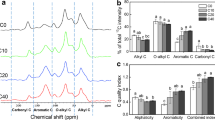Abstract
The response of a series of soil microbial, chemical, and enzymatic chacacteristics to two different tillage systems (conventional and no-tillage) and two crop rotations (continuous corn and soybean–corn) was evaluated in a long-term field experiment in the Rolling Pampas Region, Marcos Juárez, Córdoba, Argentina. The parameters studied included: oxidizable, soluble and respiration C, total and hydrolyzable N, microbial activity, ammonifiers, nitrifiers, cellulolytic and total microflora, protease and urease activities. After 15 years, oxidizable C, total N and hydrolyzable N showed no differences regarding no-tillage systems. However, differences were found regarding control soil. While soluble C did not exhibit any significant differences, respiration C and microbial activity were indicators sensitive to different treatments. Enzymatic activities, protease in particular, did reflect changes due to management. Fluctuation in microbial population counts were more related to plant residues than to tillage systems.
Similar content being viewed by others
Author information
Authors and Affiliations
Additional information
Received: 29 May 1999
Rights and permissions
About this article
Cite this article
Palma, R., Arrigo, N., Saubidet, M. et al. Chemical and biochemical properties as potential indicators of disturbances. Biol Fertil Soils 32, 381–384 (2000). https://doi.org/10.1007/s003740000266
Issue Date:
DOI: https://doi.org/10.1007/s003740000266




